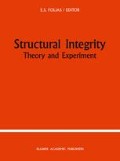Abstract
The mechanics of quasi-static crack closing and bonding of surfaces of the same or different linear viscoelastic materials is described. Included is a study of time-dependent joining of initially curved surfaces under the action of surface forces of attraction and external loading. Emphasis is on the use of continuum mechanics to develop equations for predicting crack length or contact size as a function of time for relatively general geometries; atomic and molecular processes associated with the healing or bonding process are taken into account using a crack tip idealization which is similar to that used in the Barenblatt method for fracture. Starting with a previously developed correspondence principle, an expression is derived for the rate of movement of the edge of the bonded area. The effects of material time-dependence and the stress intensity factor are quite different from those for crack growth. A comparison of intrinsic and apparent energies of fracture and bonding is made, and criteria are given for determining whether or not bonding can occur. Examples are given to illustrate use of the basic theory for predicting healing of cracks and growth of contact area of initially curved surfaces. Finally, the effect of bonding time on joint strength is estimated from the examples on contact area growth.
Résumé
On décrit le mécanisme de fermeture d’une fissure quasi-statique et de collage des surfaces de matériaux visco-élastiques linéaires indentiques ou différents. On couvre également l’étude de la liaison dans le temps de surfaces é courbure initiale sous l’effet des forces de surface résultant de l’attraction et de charges extérieures. L’accent est placé sur l’utilisation de la mécanique des milieux continus pour l’établissement d’équations permettant de prédire la longueur de fissuration et la dimension des zones et contact en fonction du temps, dans le cas de géométries relativement générates. On prend en compte les processus atmostiques et moléculaires associés aux phénomènes de cicatrisation ou de collage en recourant à une idéalisation de l’extrémité de la fissure comparable à celle utilisée dans la méthode d’analyse des ruptures due à Barenblatt. En partant d’un principe de correspondances établi précédemment, on déduit une expansion décrivant la vitesse de déplacement du bord de la zone collée. On constate que les effets de la dépendance des propriétés du matériau en fonction du temps et du facteur d’intensité de contraintes sont différents de ceux exercés sur la croissance d’une fissure. On procède à une comparaison des énergies intrinsèques et apparentes de rupture et de collage, et on donne des critères pour déterminer si un collage peut ou non avoir lieu. Des exemples illustrent l’emploi de la théorie de base pour décrire la cicatrisation des fissures et la croissance de la surface de contact de surfaces initialement courbes. Enfin, on estime l’effet du temps de collage sur la résistance du joint, à partir des exemples de croissance de la surface de contact.
Access this chapter
Tax calculation will be finalised at checkout
Purchases are for personal use only
Preview
Unable to display preview. Download preview PDF.
References
M.L. Williams, in Proceedings 5th U.S. National Congress of Applied Mechanics, American Society of Mechanical Engineers (1966) 451–464.
M.L. Williams, International Journal of Fracture Mechanics 1 (1965) 292–310.
W.G. Knauss, in Deformation and Fracture of High Polymers, H. Henning Kausch, John A. Hassell and Robert I. Jaffee (eds.) Plenum Press (1974) 501–541.
R.A. Schapery, International Journal of Fracture 11 (1975): Part I, 141–159; Part II, 369–388; Part III, 549–562.
G.S. Brockway and R.A. Schapery, Engineering Fracture Mechanics 10 (1978) 453–468.
R.M. Christensen, Theory of Viscoelasticity, An Introduction, 2nd edn., Academic Press (1982).
J.G. Williams, Fracture Mechanics of Polymers, Halstead Press, John Wiley & Sons (1984).
R.A. Schapery, International Journal of Fracture 14 (1978) 293–309.
J.R. Walton, Journal of Applied Mechanics 54 (1987) 635–641.
K.L. Johnson, K. Kendall and A.D. Roberts, Proceedings of the Royal Society (London) A234 (1971) 301–313.
A.D. Roberts and A.G. Thomas, Wear 33 (1975) 45–64.
J.A. Greenwood and K.L. Johnson, Philosophical Magazine A43 (1981) 697–711.
J.N. Anand and H.J. Karam, Journal of Adhesion 1 (1969) 16–23.
J.N. Anand and R.Z. Balwinski, Journal of Adhesion 1 (1969) 24–30.
J.N. Anand, Journal of Adhesion 1 (1969) 31–37.
J.N. Anand and L. Dipzinski, Journal of Adhesion 2 (1970) 16–22.
J.N. Anand, Journal of Adhesion 2 (1970) 23–28.
J.N. Anand, Journal of Adhesion 5 (1973) 265–267.
H.H. Kausch, D. Petrovska, R.F. Landel and L. Monnerie, Polymer Engineering and Science 27 (1987) 149–154.
K. Jud, H.H. Kausch and J.G. Williams, Journal of Materials Science 16 (1981) 204–210.
R.G. Stacer and H.L. Schreuder-Stacer, International Journal of Fracture 39 (1989) 201–216.
J.W. Button, D.N. Little, Y. Kim and J. Ahmed, Proceedings Association of Asphalt Paving Technologists 5b (1987) 62–90.
A.H. Lepie, Proceedings J ANNAF Structures and Mechanical Behavior Working Group CPIA Publication No. 351 (1981) 233–240.
R.A. Schapery, Tire Science & Technology 6 (1978) 3–47.
S.P. Timoshenko and J.N. Goodier, Theory of Elasticity, 3rd edn. McGraw-Hill (1970).
R.A. Schapery, International Journal of Fracture 25 (1984) 195–223.
M.A. Biot, Quarterly Applied Mathematics XXX (1972) 379–406.
J.D. Ferry, Viscoelastic Properties of Polymers, 3rd edn. Wiley (1980).
D. Broek, Elementary Engineering Fracture Mechanics, 4th edn. Martinus Nijhoff (1986).
T.C.T. Ting, Journal of Applied Mechanics 33 (1966) 845–854.
G.A.C. Graham, International Journal of Engineering Science 14 (1976) 1135–1142.
Author information
Authors and Affiliations
Editor information
Editors and Affiliations
Rights and permissions
Copyright information
© 1989 Kluwer Academic Publishers, Dordrecht
About this chapter
Cite this chapter
Schapery, R.A. (1989). On the mechanics of crack closing and bonding in linear viscoelastic media. In: Folias, E.S. (eds) Structural Integrity. Springer, Dordrecht. https://doi.org/10.1007/978-94-009-0927-4_14
Download citation
DOI: https://doi.org/10.1007/978-94-009-0927-4_14
Publisher Name: Springer, Dordrecht
Print ISBN: 978-94-010-6906-9
Online ISBN: 978-94-009-0927-4
eBook Packages: Springer Book Archive

